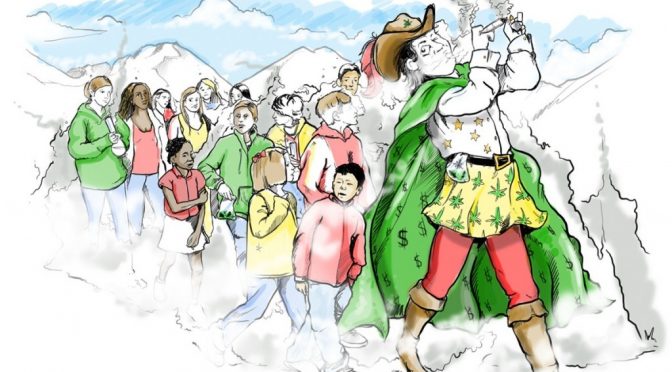Six years after adult-use marijuana commercialization began in Colorado, teens report an alarming increase in their use of ultra-potent pot products in the form of dabs and vapes, according to official state data released today. A statewide Healthy Kids Survey from last year questioned 53,520 students chosen randomly from 195 middle and high schools.
More than half of high school students who use marijuana reported that they dab marijuana to get high. Among students who reported using marijuana in the past 30 days, 52% said they dabbed it, up from 34.4% just two years ago— a 50% increase.
“Dabbing” is a method of inhaling highly concentrated THC (commonly referred to as hash oil, wax or shatter) using a blow torch-heated delivery system commonly referred to as a dab rig. THC is the main high-inducing chemical in marijuana.
The survey results also show a 69% increase in students vaping marijuana in two years. Among high school students who used marijuana in the past 30 days, 34.3% reported vaping it, up from 20.3% in 2017.

Driving under influence of pot went up, too
In addition to highlighting the increases in dabbing and vaping, the Colorado Department of Public Health and Environment noted that the percentage of youth who drove after using marijuana more than tripled in two years. According to the state, 32.4% of youth drove a vehicle after using marijuana in the past month, a statistically significant increase from 9% in 2017.
Colorado has no limits on marijuana potency and has seen levels of THC steadily rise in commercial products. Some concentrates, which make up an increasingly large share of the market, can exceed 90% THC. Those potency increases have been documented in a state funded study.
The Colorado Department of Public Health and Environment just completed a comprehensive analysis of the health effects of marijuana potency. The report acknowledged that almost 93% of products sold in Colorado are greater than 15% THC.
In the early 1990s, the average THC content in confiscated marijuana samples was less than 4%. Marijuana potency has accelerated in the past decade as marijuana commercialization expanded. In Washington, an attempt to cap the potency of marijuana products failed in that state’s legislature earlier this year.
Why dabs and vapes?
Rachel O’Bryan, an attorney and co-founder of Smart Colorado said, “It’s no surprise that kids are switching to easily concealed ultra-potent pot when they are bombarded with images and marketing for these high-THC products that have proliferated since legalization. This is not the much milder marijuana of their parents’ generation.”
Peer-reviewed scientific studies show that marijuana harms developing brains. However, researchers haven’t been able to fully explore the effects of these new ultra-potent products. A recent study found a significant association between using marijuana concentrates and progressing to more frequent use among adolescents. The study found that the persistence of use and progression of use is greatest with these concentrated THC products.
Nationwide high school use of e-cigarettes soared by 78% in a single year. Furthermore, 26 % of Colorado students, twice the national average, reported current e-cigarette use. At one time, Gov. John Hickenlooper and public health officials sounded the alarm.
O’Bryan said she hopes these latest figures will finally shock the state into action.
“Commercialized marijuana in Colorado, and the way our state has chosen to leave the industry largely unregulated, is setting our children up for future addiction,” she said. “I hope this news is a wake up call to policymakers that a serious discussion and immediate action on rampant pot potency is needed. Our children have only one chance to grow up and we as a community are failing them.”
Policy makers should consider two recent incidents of youths who died as a result of vaping, Johnny Stack and Ben Shealy. How many marijuana tragedies will occur before our politicians wake up?
Other concerns in the survey
The Department of Health survey provides insight to other concerns affecting Colorado children. The rate of students reporting periods of depression lasting two weeks or more rose to 34.7%. The percent of students seriously considering suicide, 17.5%, and the percent of youth who attempted suicide, 7.6%, did not significantly rise from 2017.
Colorado’s public officials should be very concerned, but they won’t stop supporting the marijuana industry. Colorado has one of the highest suicide rates in the nation, a rate that matches its high rate of drug and alcohol abuse.
In the past, we’ve noted the connection between teen suicides and marijuana use. We’ve warned parents not to send your student to college in Colorado. Since we wrote that article, the son of yet another celebrity, died in Denver. Beckett Cypher, son of Melissa Etheridge, who once bragged of smoking pot with her children, succumbed to his opioid addiction.
How does Colorado’s reputation as a healthy state square off against the depressing statistics of the survey? How can we keep losing so many of our children who should be entering the prime of life? The United States should reconsider how our dysfunctional politics, educational system and toxic culture are damaging our youth.

